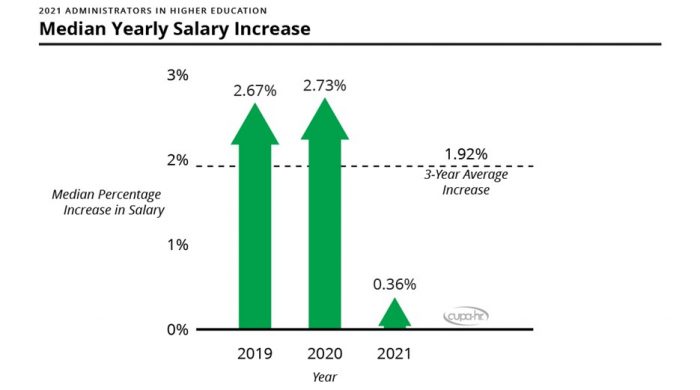PRESS RELEASE
FOR IMMEDIATE RELEASE
April 26, 2021
No Pay Increases for Higher Education Administrators
The severe budget cuts in the wake of the COVID-19 pandemic forced many colleges and universities to freeze hiring, cut positions, and, in some cases, decrease salaries. This report highlights the overall changes to higher ed administrator composition and salaries over the past year.
In the midst of large pandemic-related budget cuts, higher ed administrators overall received near-zero pay increases. According to CUPA-HR’s Administrators in Higher Education Annual Report released today, when salary increases occurred in the higher ed workforce over the past year, they tended to go to faculty, professionals and staff rather than administrators.
The overall median salary increase for administrators from 2019-20 to 2020-21 was 0.36 percent, the lowest increase since 2010, when the last recession occurred. The low increase is particularly striking when compared to the previous two years, with median salary increases of 2.73 percent in 2019 and 2.67 percent in 2020. This year’s increase was the lowest of any sector of the higher ed workforce — lower than that for faculty, professionals or staff.

The only category of administrators to receive what could be considered a salary increase were heads of divisions, who are among the lowest-paid administrators, with a slight increase of 0.403 percent. Every other category of administrator received no increase or a near-zero increase.
Other key findings of the survey include:
- The size of the administrator workforce overall did not change greatly over the past year. In 2019-20, the number of administrators decreased by 0.4 percent. In 2020-21, the number of administrators increased slightly by 0.2 percent. Master’s and doctoral institutions increased the number of administrators reported, whereas baccalaureate and associate’s institutions decreased their administrator workforce size.
- The proportions of women and racial/ethnic minorities within administrative positions are not much different from last year, indicating that cuts made during the past year did not disproportionately impact the representation of women and minorities in administrative positions overall.
- Continuing trends from past years, women are less represented in higher-paying administrative positions and more represented in lower-paying positions. For all administrative categories, women are paid less than men. The pay gap between women and men is most pronounced among deans and associate/assistant deans.
- Black, Hispanic/Latinx, and Asian men make up less than one-tenth of administrators (7 percent). Minority women also make up less than one-tenth of administrators (9 percent) but are slightly better represented among administrators overall than are minority men.
- For presidents, executive perks may have been impacted by budget challenges created by the pandemic. In 2020-21, fewer presidents received a car, club membership, and/or housing subsidies.
A total of 47,985 administrators were reported for this year’s survey by 1,053 higher education institutions. The 202 positions surveyed include top executive officers; senior institutional and chief functional officers; institutional administrators; heads of divisions, departments and centers; academic deans; and academic associate/assistant deans.
To learn more about the Administrators in Higher Education Survey, read the overview. Salaries, demographic comparisons and detailed trend information are available in the full report.
About CUPA-HR
CUPA-HR is the recognized authority on compensation surveys for higher education, with its salary surveys designed by higher ed HR professionals for higher ed HR professionals and other campus leaders. This marks the 54th year of data collection on higher education administrators, the longest-running of CUPA-HR’s surveys. Learn more about CUPA-HR research.
CUPA-HR is higher ed HR. We serve higher education by providing the knowledge, resources, advocacy and connections to achieve organizational and workforce excellence. Headquartered in Knoxville, Tennessee, and serving over 33,000 HR professionals and other campus leaders at nearly 2,000 member institutions and organizations around the country and abroad, the association offers learning and professional development programs, higher education salary and benefits data, extensive online resources and just-in-time regulatory and legislative information.
Contact Information
Erin Rosolina
Marketing Manager – Communications and Marketing
[email protected]


